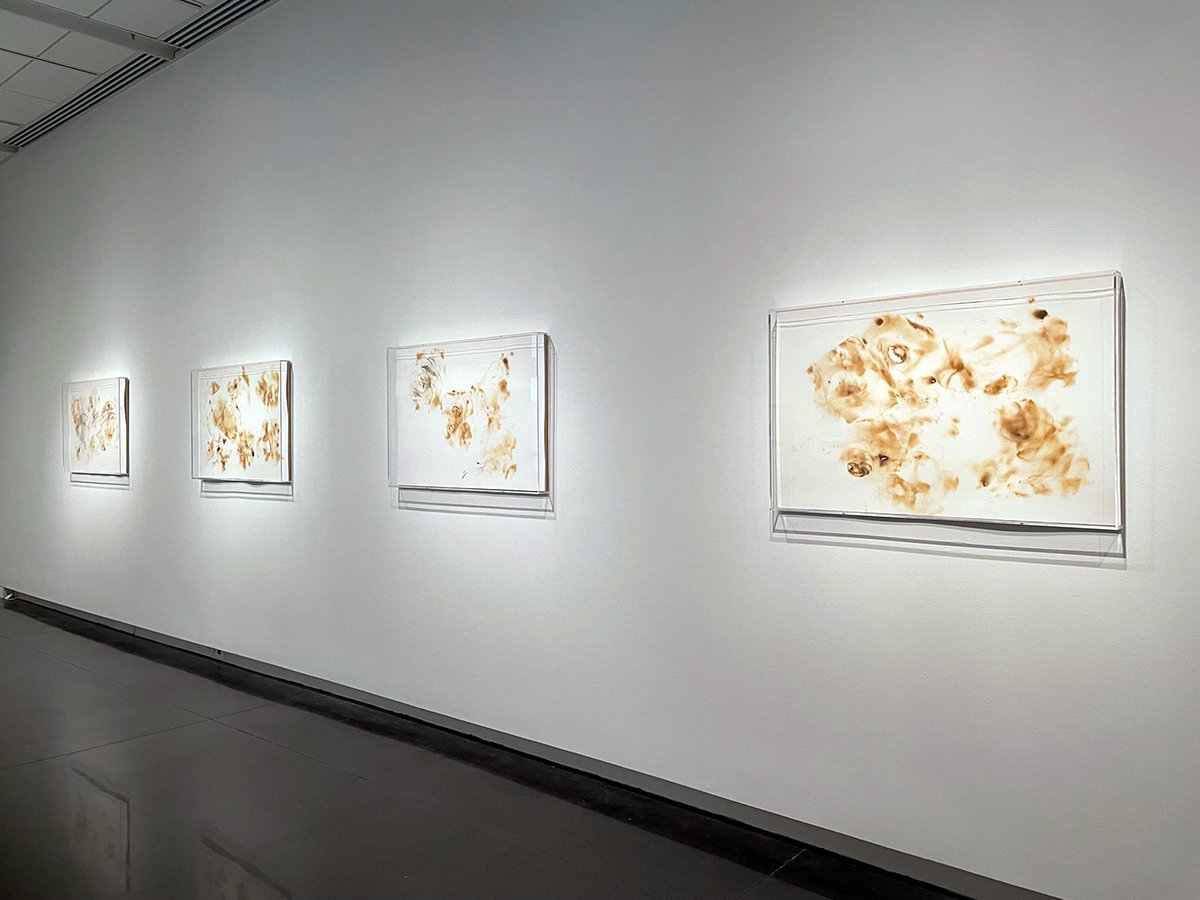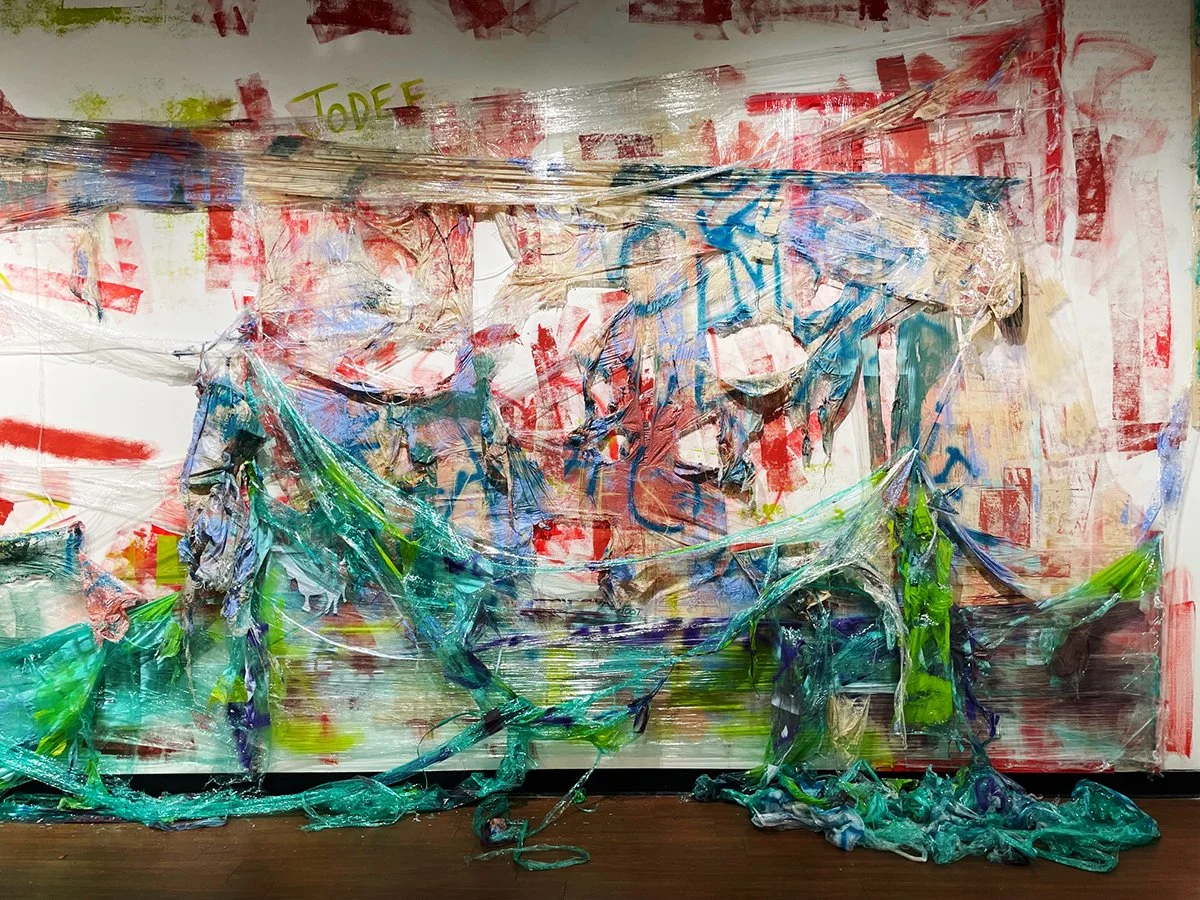Faculty Exhibition: 2023
Faculty Exhibition: 2023
University of Colorado Art Museum
1085 18th Street, Boulder, CO 80309
September 8-December 22, 2023
Admission: Free
Review by Clarissa Gucwa
The University of Colorado Art Museum’s Faculty Exhibition: 2023 brings together works by twenty-three CU Boulder faculty members. [1] The media represented in the show include ceramics, film, multimedia installations, painting, photography, and sculpture, among others. Each artist tells stories through their work about time and experience becoming tangible in their art making practice. It is through their stories that we see how students will begin to tell their own.
An installation view of the Faculty Exhibition: 2023 at the CU Art Museum. Image by Wes Magyar, © CU Art Museum.
This exhibition begins in the doorway. The entrance is enveloped by Alvin Pagdanganan Gregorio’s mural titled Pasok Na. Gregorio is an Associate Professor of Painting and Drawing in the Department of Art and Art History. Demonstrating an active relationship with the physical body of the museum, the title Pasok Na could be translated from Filipino to English as “enter.”
Alvin Pagdanganan Gregorio, Pasok Na, 2023, mixed media site-specific wall painting. Image by DARIA.
The mural spans the wall from floor to ceiling, starting at the bottom as a deluge of blacks, grays, and browns, and growing to take the shape of a giant skull whose teeth clench onto the top of the doorframe, while also creating a pedestal for a face full of life. Flowers, skulls, and biomorphic shapes frame and cradle the living being. Pasok Na demonstrates how art allows the imaginary to become reality in a physical space. The ephemeral nature of the mural further evokes the cyclical experiences of academic and creative growth that occur in the academic space.
An installation view of Anna Tsouhlarakis’ Drawing I, Drawing II, Drawing V, Drawing VI, 2020, fire and ash on paper. Image by DARIA.
As a viewer enters through the mural's threshold, they can see that each faculty member’s work is given its own space and each piece conceptually leads to the next. Pasok Na’s understanding of ideas as part of the physical structure of institutions is also reflected in four drawings by Anna Tsouhlarakis. Tsouhlarakis is of Greek descent, a member of the Navajo Nation, and an Assistant Professor of Foundations.
Anna Tsouhlarakis, Drawing III (Burned propaganda used for Native American relocation and assimilation, marks not evenly dispersed), 2020, fire and ash on paper. Image courtesy of the artist.
She created Drawing I, Drawing II, Drawing V, and Drawing VI from the fire and ash of documents that were used as tools of colonization, including the Declaration of Independence and propaganda for Native American relocation and assimilation. These documents represent ideas and belief systems that became reality through the impacts of colonization on Native communities both in the past and present. Part of teaching and learning about one’s own art making practice is understanding how art and history are intertwined.
Michael Theodore, Why Four? (painting), Tang’s Song (sound), Artist Statement (text and drawings), 2023, acrylic on canvas, text, ink on paper, and sound. Image by Clarissa Gucwa.
Understandings of time in relation to experience and personal history are integral to Michael Theodore’s work, which occupies a wall of its own in the middle of the exhibition space. Professor Theodore teaches music composition and technology as well as interactive media and holds appointments in both the College of Music and the Department of Art and Art History. His works on display include Why Four?, Tang’s Song, and Artist Statement, all of which are part of the intermedia project called The Garden—a conceptual, world-building project. [2]
Michael Theodore, Tang’s Song (sound) and Artist Statement (text and drawings), 2023, text, ink on paper, and sound. Image by DARIA.
Artist Statement includes both text and drawings bound in a blue binder that the viewer can peruse while wearing headphones in order to listen to Tang’s Song. The recording is a somber yet hopeful tale of Petra, a friend of Theodore’s who is lost but later found in The Garden. The acrylic painting Why Four? depicts Petra and other characters who are part of this world. The layers of visual, linguistic, and auditory experiences welcome the viewer to immerse themselves into this world and demonstrate to students how conceptual ideas can be a medium for creating infinite possibilities.
Martha Russo, incubo, 2020-2023, Buddha’s hand, cactus buds, glass, glaze materials, Egyptian paste, Karo syrup, low-fire casting slip, metal, paper clay, Petri dishes, porcelain, porcelain casting slip, protea, Pyrex, roofing nails, rug, shellac, and underglaze. Image by DARIA.
The visualization of fragments of time that Theodore explores is also foundational to Martha Russo’s incubo. Russo is a lecturer in the Department of Art and Art History and a member of the Artnauts—an artist collective that strives for global change through the visual arts. Incubo is a collection of ceramic and mixed media forms displayed in Petri dish-shaped vessels. She began these works during the COVID-19 lockdown as an exploration of the memory of objects and they are an attempt “to make visual the horrors of the mysterious virus gripping the world.” [3]
A detail view of Martha Russo’s incubo, 2020-2023, Buddha’s hand, cactus buds, glass, glaze materials, Egyptian paste, Karo syrup, low-fire casting slip, metal, paper clay, Petri dishes, porcelain, porcelain casting slip, protea, Pyrex, roofing nails, rug, shellac, and underglaze. Image by Clarissa Gucwa.
Incubo communicates how objects can symbolize a singular moment, or a cessation of time. The feeling of scientific investigation comes across as viewers circle the table to examine the shallow, circular dishes of overflowing organic shapes, each evoking memories of a lived experience through color, shape, and texture. Students may learn about how to explore the possibilities of their own artmaking practice through foundational investigations such as this. For it is through elemental fragments that many of us have started to grapple with how to build and move forward after a period when our sense of time and place was paused.
Melanie Yazzie, rebuilding, 2023, mixed media. Image by DARIA.
Working in the same vein of exploration as Russo, Melanie Yazzie’s piece rebuilding captures moments through familiar forms. Yazzie is a Professor of Printmaking who makes mixed media works, paintings, prints, and sculptures that are deeply influenced by her Diné (Navajo) cultural heritage. Rebuilding is a collection of 132 mixed media images displayed in rows on the wall.
A detail view of Melanie Yazzie’s rebuilding, 2023, mixed media. Image by DARIA.
This display allows us to notice the repetition of familiar forms, such as a triangle on top of a square, which alludes to a home. This recurrence, along with Yazzie’s frequent use of maps, stitches hand-sewn along repeating lines, and abstract shapes demonstrate how rebuilding often means drawing on foundational knowledge and experience. Students and teachers rebuild ideas through small moments of repeated awareness and familiarity that grow at every stage of the creative process.
An installation view of the Faculty Exhibition: 2023 at the CU art Museum. Image by Wes Magyar, © CU Art Museum.
While each work in the Faculty Exhibition stands on its own, it is clear that there are also paths that meet and diverge between practices and ideas, demonstrating how learning is a journey through different phases of time, life, and experience. Cycles of exploration are manifest in the work of Gregorio, Tsouhlarakis, Theodore, Russo, and Yazzie as they grapple with how to make sense of their worlds. Individual stories are part of a network of connections that continue to take shape and grow as both teachers and students share their perspectives and experiences. And surely it is through our teachers’ knowledge and guidance that we learn how to tell our own stories.
Clarissa Gucwa (she/her) is a graduate student studying art history at the State University of New York at Purchase College. Her research interests include Latin American art of the twentieth century, art in public spaces, and institutional critique. Her work explores how collecting and exhibition practices shape our understanding of artworks, artifacts, and cultural objects.
[1] The artists included in the exhibition are Mark Amerika, Luis Valdovino and Dan Boord, August Black and Betsey Biggs, Scott Chamberlin, Matt Christie, Laura Devendorf, Kim Dickey, Erin Espelie, Steven Frost, Alvin Gregorio, Marina Kassianidou, Jeanne Liotta, Jeanne Quinn, Yumi Janairo Roth, Martha Russo, Richard Saxton, Joel Swanson, Anna Tsouhlarakis, Michael Theodore, Mike Womak, and Melanie Yazzie.
[2] From Michael Theodore’s Artist Statement. These works can also be experienced online at https://michaeltheodore.info/statement.html.
[3] From Martha Russo’s Artist Statement.


















